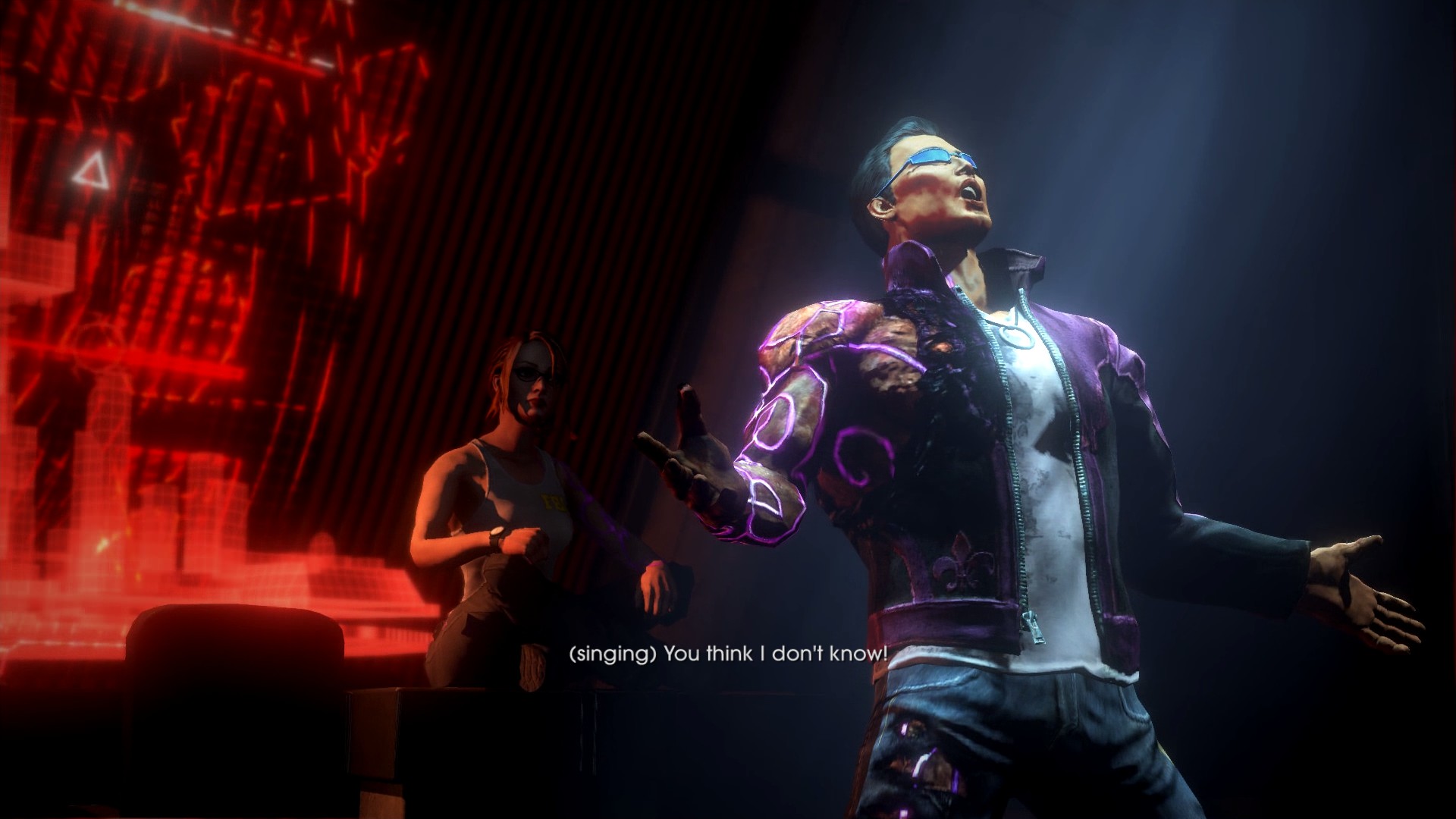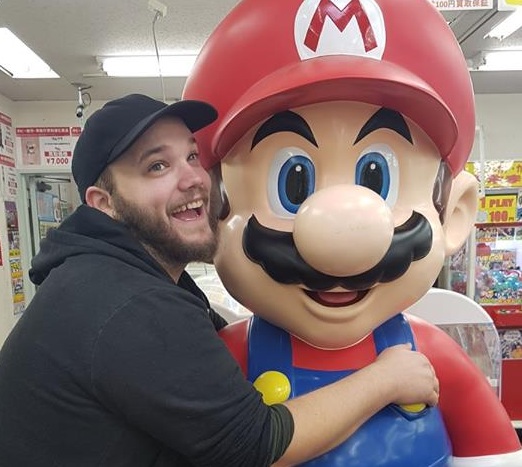
Well, I’m glad I didn’t pay for this one. Saints Row: Gat Out Of Hell (or SR:GooH, hee hee) stumbles its way down the paved path of good intentions, hampered by bugs and awful design choices. There are elements of this game that I love and when I’m done writing this review I’m probably going to go back and try to %100 it. That’s mostly because I’m a long-time fan of the series, it endears itself to me with just about every iteration. This game, however, is that “just about,” an unruly offspring to dismantle the (apparent?) corner that the devs wrote themselves into with the last game. Just like a problem child, it’s difficult to love and I really wish it had followed the examples of its older siblings.

There is so much squandered potential in SR:GooH that it’s genuinely upsetting as a fan of the franchise, not the least of which was the narrative. The way in which it was handled and delivered to the player, much like the rest of the game, was a poorly executed good idea. No matter what missions you do within the city, it progresses the storyline towards the ending. I should really say that it “forces” you towards the ending, as these missions don’t even have to be story critical. This was the case for me, finishing the game the first time with only half of the side-but-not-quite-side characters. There was even a brief though entertaining musical section which was introduced apropos of nothing about a third of the way in and then dropped just as quickly when I assume the writers got bored.
The gameplay is fairly typical of the previous games in the franchise, but it’s composed of so many ill-fitting elements. For starters, the missions that provide you story context are those which are tied to the side-characters: Shakespeare, Vlad the Impaler, Blackbeard and returning characters the DeWynter Sisters. There’s no indication that they provide so much plot info, all of which is very necessary to understand the world you’re in and all of which totally non-mandatory. They aren’t even essential, since the extra powers they give you are totally unnecessary to beating the game. I finished the first time with only two of the powers, only one of which I really used: Stomp. Stomp was great, it killed everything. On my second play-through I also discovered that I was right to trust in it, as all the other powers were useless in comparison.

Stomping sound YES I DO SATAN
The flying, though initially clumsy and difficult to control without upgrades, is pretty fun once you get a short way into things and ended up being my favorite part of the game. Some of the side missions that are based around it are also a lot of fun, even if they were re-hashed ideas from the previous games. It gave the overall impression of being a much better version of SR:IV’s flight mechanics. It also made picking up collectibles more enjoyable, as much as an unabashed collect-a-thon can be, which actually are totally essential to progressing. The soul clusters which you pick up are needed to purchase power upgrades, without which the game is nigh-impossible to beat. So, just so we’re clear so far: Story missions? Not important. Side missions? Absolute requirement for progression.
This wouldn’t be so bad except that, as previously mentioned, the game forces you towards the ending with just about every action you do. In classic Saints Row fashion, the final boss – in this case, Satan – is constantly dangled in front of your face right from the start. In this way, SR:GooH does an excellent job of personifying the villain and making him a likable and genuinely funny character. Given time, it might have even been able to cultivate a really great love-to-hate relationship with the player; unfortunately, SR:GooH is in an inexplicable rush. The game is broken up into three major acts, represented as a progress bar in the game’s menu, and completing missions of any kind will fill it up. In terms of how many missions are required to fill said bar, there is an unnecessary abundance available.

You used to be cool, Gat. You’re still cool, kinda, but you’re also neutered now.
I don’t know about most people, but I like play Saints Row campaign missions in my own way: as a towering deity forged from guns and explosions while wielding both like play things. I usually accomplish this by doing a whole bunch of the side activities before anything else and my approach to SR:GooH was no different though this was pushing me towards the end of the game story. The game doesn’t really make it very clear that that’s exactly what it’s doing, however. I didn’t actually realise that this was what was happening until I got shunted into the final boss fight.
The forced story progression also highlights just how short the story of the game is, as well as the developers disregard for the usual level of player agency present in Saints Row games. The bulk of the gameplay in SR is 100%ing the various activities around the city and the game still lets you do this, but only after you’ve beaten Satan. Before that, you have to just use whatever you’ve accumulated in the lead up to that last fight. Again, that’s a really interesting concept and one I’d love to see implemented with intention instead of accidental brilliance. The rest of the games design just isn’t suited for this though and, because of the general lack of direction, you’ll likely be woefully unprepared for your first fight against Satan.

There will be none of this.
I played the game twice because there are two characters available and five different endings, so I figured it would be worth the second play through. It was, but only in the sense that it was worth it to see how little effort the developers put in overall. Gat is very much in the leading role, with almost the whole of the story centered on him, which raised a puzzling question for me: Why is Kinzie here? Aside from the flimsy pretext of the Birthday Ouija board used during her party, I mean. Because, beyond that, her characterisation is nil and I’m not just talking in the sense of character development throughout the narrative either. I mean that she just gets ignored for a good chunk of the game.
If you’re playing as Kinzie, whom you have to switch to as the game doesn’t give you a choice of character from the start, Gat is still the character that appears in cutscenes. This even includes the tutorial videos, which is just really lazy. Her dialogue is often copied from Gat’s outright and, when it’s not, it’s usually along the lines of “whee!” and “woo!” Along with the generally bubbly attitude she displays throughout the game, it feels totally in conflict with her established character from the previous games. That might have been fine were it not for the totally absent context or explanation. Kinzie is a great character and this could have been a chance for the player to experience how she thinks and acts. Instead, she’s been relegated to the role of “goofy side-kick;” this is a pretty desperate attempt to shoe-horn in co-op multiplayer and a female protagonist all at once.

SURPRISE! IT’S A DISAPPOINTMENT!
Don’t misunderstand me, here, I’m not angry that Kinzie is present at all. If they’d included her and really fleshed out her character, then a second play through would have been really rewarding for the player. Their decision to include a watered down version of her, however, meant that attention was also taken away from Gat’s character development. I don’t understand why it was necessary to include a second, female character. There’s nothing wrong with a single player game with a strong character and, especially in this context, there’s nothing wrong with that character being male. The result was a feeling of him being “half-finished,” and that’s a sentiment which carries into the rest of the games world and character designs.
Some recurring characters are zombies while others aren’t and it never gets explained why. The world is a re-skin of Steelport again, because, of course, that feels more like “Hell on Earth” instead of an actual Hell dimension and the bugs. Oh, the bugs. I feel like when the game uses the same engine and a lot of existing assets from a title which has only just recently been “remastered,” that the amount of bugs should be few to none. Cut scene audio would regularly cut out until I restarted the game. Loading screens which would load forever, without actually loading anything. There were times when I could punch the reload button through my keyboard and my character would just stand there vacantly. That last one might just be a result of the fact that I was playing a PC port, however, because to say that SR:GooH hasn’t been optimised for PC would be an understatement. There was more, but I only have so many words here and I think I’ve gotten my point across.

You should learn to heed your own art design, Volition.
 Fun flight mechanic
Fun flight mechanic
 Interesting ideas
Interesting ideas
 Occasional funny dialogue
Occasional funny dialogue
 Confusing story progression
Confusing story progression
 Lots of bugs
Lots of bugs
 Uninspired visual design
Uninspired visual design
 Poor character development
Poor character development
 Too many to list
Too many to list
I think the biggest disappointment were the endings; despite there being five of them, they all probably amount to about two minutes of unimaginative dialogue. There was one, in particular, that made the purpose of SR:GooH painfully clear and made the weak effort that much worse. I could almost feel the nudging in my ribs while it winked coyly and pointed at the inevitable sequel on the horizon. If SR:GooH was to be nothing more than a short bridge between major entries in the franchise, and it is absolutely nothing else, then it could have been amazing. They could have made it a short musical, set in hell, with an open world that allows progression at your own pace and the entire thing would have been entirely about Johnny Gat, with all the development effort going into him. Volition, that’s a rad idea – what the hell happened?

Do it Johnny.
EDITOR NOTE: this game was provided to us by the publisher, and reviewed on PC across 16 hours of gameplay.











